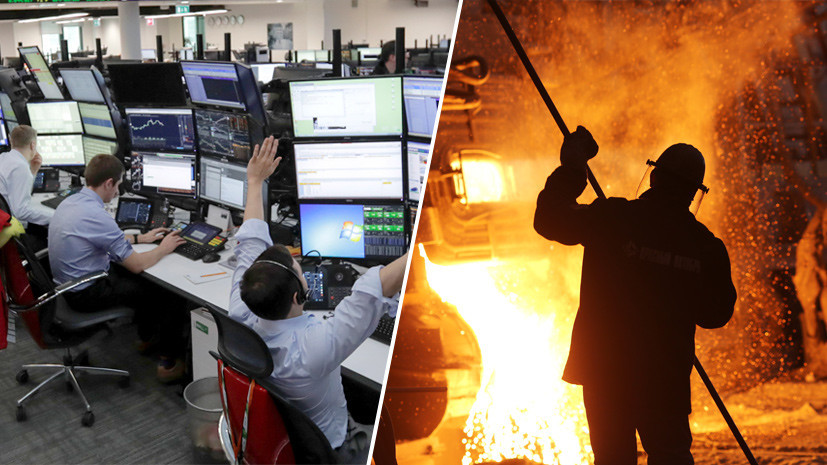Since the beginning of 2019, business activity in the manufacturing industry of Russia has shown mixed dynamics. The corresponding PMI fell from January to February, but already in March it accelerated to a two-year high and reached 52.8 points. However, after that, the indicator began to fall again and by the end of September amounted to 46.3 points. The value has become the lowest in ten years. Such data are presented in a review of the analytical agency IHS Markit.
Traditionally, the PMI index reflects the real state of a particular industry. A value above 50 points indicates a positive economic situation, below 50 points - the stagnation of the sector.
“Russian manufacturers in September pointed to the fastest drop in performance since April 2009. The decline in production was largely due to the decrease in new orders and the loss of customers, ”says the IHS Markit study.
As the director of the LOCO-Invest analytical department, Kirill Tremasov, explained in an interview with RT, Russia was influenced by the global slowdown in industry. According to the latest data from JP Morgan, the index of business activity in the global manufacturing sector for five months remains below the psychological mark of 50 points. According to Tremasov, trade wars became the main reason for such dynamics.
Recall that in 2018, the United States began to levy increased duties on goods imported from China. The authorities of the Asian Republic introduced similar measures against Washington. The parties repeatedly tried to agree on a mutually beneficial trade transaction, but each time the discussion ended with the introduction of new duties.
As a result, in May 2019, China's industrial PMI broke through the level of 50 points and today still remains below this mark. At the same time, in the USA the indicator reached its minimum level since the summer of 2009 and in September amounted to 47.8 points.
It is noteworthy that the trade war between the USA and China also hit Europe significantly. This was told in an interview with RT by an expert at the Academy of Finance and Investment Management Gennady Nikolaev. According to the latest data, the Eurozone manufacturing PMI updated its seven-year low and fell to 45.7 points.
“States whose economies depend on the state of global trade are going through hard times. The World Bank has already worsened forecasts for the growth rate of world trade almost doubled - up to 1.2%. The aggressive behavior of the US government disrupted international sales chains: China's GDP growth is declining, which negatively affects one of the main exporters of China - Germany. As a result, the negative effect has spread to other European countries, ”Nikolaev explained.
According to the FCS, in 2018, the eurozone and China occupied the largest shares in Russian exports - 34% and 12.5%, respectively. Thus, a drop in business activity among key buyers of national products caused a decrease in orders from Russian manufacturers, Nikolaev said.
Demand for services
The fall in business activity in Russian industry is accompanied by a record acceleration in the country's services sector. According to IHS Markit estimates, in September, the corresponding PMI reached its highest level since April and climbed to 53.6 points.
“Support for the service sector was the growth, albeit relatively restrained, of new orders. Accordingly, companies have increased the number of jobs for the first time since April, ”said IHS Markit.
In many respects, the growth of the service sector is facilitated by stable domestic demand. In an interview with RT, BCS Prime Analyst Anton Pokatovich explained this by expanding the consumer lending market.
“In 2018, the volume of paid services to the population amounted to about 9.5% of GDP, and in the first six months of 2019, this share slightly increased to 10-11% of GDP. The dynamics of the services sector to some extent reflects the state of consumer demand in the economy. Although domestic demand itself is now under pressure, it is very seriously supported by the growth of consumer lending, ”Pokatovich explained.
Moreover, analysts also connect the growth of the service sector with the transition of Russian entrepreneurs to a service business model. It implies that customers, instead of buying the equipment necessary for the operation, rent it. This strategy allows the business to reduce short-term costs.
“The service business model is actively being introduced in production. For example, companies are increasingly leasing the equipment they manufacture with their subsequent maintenance. In part, this trend may affect the growth of business activity in the services sector, ”Ivan Kapustyansky, a leading Forex Optimum analyst, explained in an interview with RT.
Interviewed RT experts differently assess the future prospects of the Russian services sector. Kirill Tremasov believes that in the near future the sector may begin to slow down after industry.
“The observed growth in business activity may be temporary. Often, if the situation in the industry changes, after a certain time the services react accordingly, ”the expert explained.
At the same time, Anton Pokatovich considers it possible to strengthen business activity in the Russian industry as early as 2020. As a result, the service sector will also continue to grow.
“If the economy can be accelerated in 2020 due to the full-scale start of the implementation of national projects, as well as the impulse from state investments, then business activity in industry will recover. In other words, we expect that the imbalance in business activity between services and industry will come to balance, ”Pokatovich concluded.

